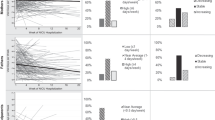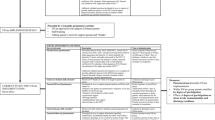Abstract
Objective:
High-risk infants are commonly referred to Visiting Nurse Association (VNA) agencies for post-hospitalization services after discharge from the neonatal intensive care unit (NICU). Little is known about the effectiveness and perceived benefits of routine VNA services for these infants. The objective of this study was to identify factors predictive of family satisfaction with VNA services after NICU discharge.
Study Design:
This is an observational study using data collected from routine quality assurance phone calls to families after NICU discharge. The setting is a single NICU at a large, urban academic medical center in Boston, MA, USA. We included all hospitalized infants discharged from the NICU from 1 January 2008 to 31 July 2014. Predictors included markers of infant biological and social risk and a survey measure of parent and nurse perceptions of parents’ preparedness at discharge. The outcome was parent response to the question, ‘Did you find the VNA visit helpful?’ at 2 weeks post discharge.
Results:
Bivariate analyses showed perceived helpfulness of VNA visits associated with low maternal parity, lower 1-min Apgar score, lower birth weight and gestational age, diagnosis of respiratory distress syndrome and intraventricular hemorrhage and low discharge readiness scores. Only low maternal parity (odds ratio (OR) 1.82, 95% confidence interval (CI) 1.35, 2.46) and birth <35 weeks’ gestation (OR 1.45, 95% CI 1.15, 1.83) were significant predictors in multivariable analysis.
Conclusions:
Low maternal parity and gestational age <35 weeks predicted parent satisfaction with VNA services. Referral for VNA services is common after NICU discharge. There are currently no guidelines indicating which infants and families stand to benefit most from such services. Our findings may help in developing and streamlining processes for post-hospitalization VNA service referrals for high-risk infants.
This is a preview of subscription content, access via your institution
Access options
Subscribe to this journal
Receive 12 print issues and online access
$259.00 per year
only $21.58 per issue
Buy this article
- Purchase on Springer Link
- Instant access to full article PDF
Prices may be subject to local taxes which are calculated during checkout
Similar content being viewed by others
References
Osterman MJ, Martin JA, Mathews TJ, Hamilton BE . Expanded data from the new birth certificate, 2008. Natl Vital Stat Rep 2011; 59 (7): 1–28.
McCormick MC, Litt JS, Smith VC, Zupancic JA . Prematurity: an overview and public health implications. Annu Rev Public Health 2011; 32: 367–379.
Selling KE, Carstensen J, Finnstrom O, Josefsson A, Sydsjo G . Hospitalizations in adolescence and early adulthood among Swedish men and women born preterm or small for gestational age. Epidemiology 2008; 19 (1): 63–70.
Smith VC, Zupancic JA, McCormick MC, Croen LA, Greene J, Escobar GJ et al. Rehospitalization in the first year of life among infants with bronchopulmonary dysplasia. J Pediatr 2004; 144 (6): 799–803.
Gray JE, McCormick MC, Richardson DK, Ringer S . Normal birth weight intensive care unit survivors: outcome assessment. Pediatrics 1996; 97 (6 Pt 1): 832–838.
Merritt TA, Pillers D, Prows SL . Early NICU discharge of very low birth weight infants: a critical review and analysis. Semin Neonatol 2003; 8 (2): 95–115.
Behrman RE, Butler AS . Preterm Birth: Causes, Consequences, and Prevention. Washington, DC, 2007.
United States. Congress. Office of Technology Assessment. Neonatal Intensive Care for Low Birthweight Infants: Costs and Effectiveness. For sale by the Supt. of Docs., US GPO. Washington, DC: Congress of the United States, 1987.
McCormick MC, Richardson DK . Access to neonatal intensive care. Future Child 1995; 5 (1): 162–175.
American Academy of Pediatrics Committee on Fetus and Newborn. Hospital discharge of the high-risk neonate—proposed guidelines. Pediatrics 2008; 122 (5): 1119–1126.
Smith VC, Young S, Pursley DM, McCormick MC, Zupancic JAF . Are families prepared for discharge from the NICU[quest]. J Perinatol 2009; 29 (9): 623–629.
Greta LL, Kathryn HA, Johanna F . Transition of premature infants from hospital to home life. Neonatal Netw 2012; 31 (4): 207–214.
Howe TH, Sheu CF, Wang TN, Hsu YW . Parenting stress in families with very low birth weight preterm infants in early infancy. Res Dev Disabil 2014; 35 (7): 1748–1756.
Melnyk BM, Crean HF, Feinstein NF, Fairbanks E . Maternal anxiety and depression after a premature infant's discharge from the neonatal intensive care unit: explanatory effects of the creating opportunities for parent empowerment program. Nurs Res 2008; 57 (6): 383–394.
Johnson S, Ring W, Anderson P, Marlow N . Randomised trial of parental support for families with very preterm children: outcome at 5 years. Arch Dis Child 2005; 90 (9): 909–915.
Pinelli J . Effects of family coping and resources on family adjustment and parental stress in the acute phase of the NICU experience. Neonatal Netw 2000; 19 (6): 27–37.
Teti DM, Hess CR, O'Connell M . Parental perceptions of infant vulnerability in a preterm sample: prediction from maternal adaptation to parenthood during the neonatal period. J Dev Behav Pediatr 2005; 26 (4): 283–292.
Commonwealth of Massachusetts Department of Health and Human Services. Massachusetts home visiting models. Boston, MA, 2014.
Avellar S, Paulsell D, Sama-Miller E, Del Grosso P . Home Visiting Evidence of Effectiveness Review: Executive Summary: Office of Planning, Research and Evaluation, Administration for Children and Families. US Department of Health and Human Services: Washington, DC, 2014.
Zahr LK, Montijo J . The benefits of home care for sick premature infants. Neonatal Netw 1993; 12 (1): 33–37.
Smith VC, Dukhovny D, Zupancic JA, Gates HB, Pursley DM . Neonatal intensive care unit discharge preparedness: primary care implications. Clin Pediatr (Phila) 2012; 51 (5): 454–461.
Caplan G . Patterns of parental response to the crisis of premature birth: a preliminary approach to modifying the mental-health outcome. Psychiatry 1960; 23: 365–374.
Kaplan DM, Mason EA . Maternal reactions to premature birth viewed as an acute emotional disorder. Am J Orthopsychiatry 1960; 30: 539–552.
Gennaro S . Postpartal anxiety and depression in mothers of term and preterm infants. Nurs Res 1988; 37 (2): 82–85.
Catlett AT, Miles MS, Holditch-Davis D . Maternal perception of illness severity in premature infants. Neonatal Netw 1994; 13 (2): 45–49.
Miles MS, Funk SG, Kasper MA . The stress response of mothers and fathers of preterm infants. Res Nurs Health 1992; 15 (4): 261–269.
Shields-Poe D, Pinelli J . Variables associated with parental stress in neonatal intensive care units. Neonatal Netw 1997; 16 (1): 29–37.
Brooten D, Gennaro S, Brown LP, Butts P, Gibbons AL, Bakewell-Sachs S et al. Anxiety, depression, and hostility in mothers of preterm infants. Nurs Res 1988; 37 (4): 213–216.
Gennaro S, Stringer M . Stress and health in low birthweight infants: a longitudinal study. Nurs Res 1991; 40 (5): 308–311.
Cronin CM, Shapiro CR, Casiro OG, Cheang MS . The impact of very low-birth-weight infants on the family is long lasting. A matched control study. Arch Pediatr Adolesc Med 1995; 149 (2): 151–158.
Robson AL . Low birth weight and parenting stress during early childhood. J Pediatr Psychol 1997; 22 (3): 297–311.
Wereszczak J, Miles MS, Holditch-Davis D . Maternal recall of the neonatal intensive care unit. Neonatal Netw 1997; 16 (4): 33–40.
Singer LT, Salvator A, Guo S, Collin M, Lilien L, Baley J . Maternal psychological distress and parenting stress after the birth of a very low-birth-weight infant. JAMA 1999; 281 (9): 799–805.
Broussard ER . Assessment of the adaptive potential of the mother-infant system: the neonatal perception inventories. Semin Perinatol 1979; 3 (1): 91–100.
Stern M, Hildebrandt KA . Prematurity stereotyping: effects on mother-infant interaction. Child Dev 1986; 57 (2): 308–315.
Ortenstrand A, Winbladh B, Nordstrom G, Waldenstrom U . Early discharge of preterm infants followed by domiciliary nursing care: parents' anxiety, assessment of infant health and breastfeeding. Acta Paediatr 2001; 90 (10): 1190–1195.
Osman H, Chaaya M, El Zein L, Naassan G, Wick L . What do first-time mothers worry about? A study of usage patterns and content of calls made to a postpartum support telephone hotline. BMC Public Health 2010; 10: 611.
Rush JP, Kitch TL . A randomized, controlled trial to measure the frequency of use of a hospital telephone line for new parents. Birth 1991; 18 (4): 193–197.
Acknowledgements
We thank Heidi Gates, RN for her dedication in performing follow-up phone calls to all of our high-risk infants and their families after discharge and David Miedema for his help in acquiring the data. We received no financial support to conduct this study.
Author information
Authors and Affiliations
Corresponding author
Ethics declarations
Competing interests
The analyses presented in this manuscript are the original work of the authors. The paper is unpublished and is not currently under review by any other publication. The authors declare no conflict of interest.
Rights and permissions
About this article
Cite this article
Awindaogo, F., Smith, V. & Litt, J. Predictors of caregiver satisfaction with visiting nurse home visits after NICU discharge. J Perinatol 36, 325–328 (2016). https://doi.org/10.1038/jp.2015.195
Received:
Revised:
Accepted:
Published:
Issue Date:
DOI: https://doi.org/10.1038/jp.2015.195
This article is cited by
-
Telemedicine, a tool for follow-up of infants discharged from the NICU? Experience from a pilot project
Journal of Perinatology (2020)



